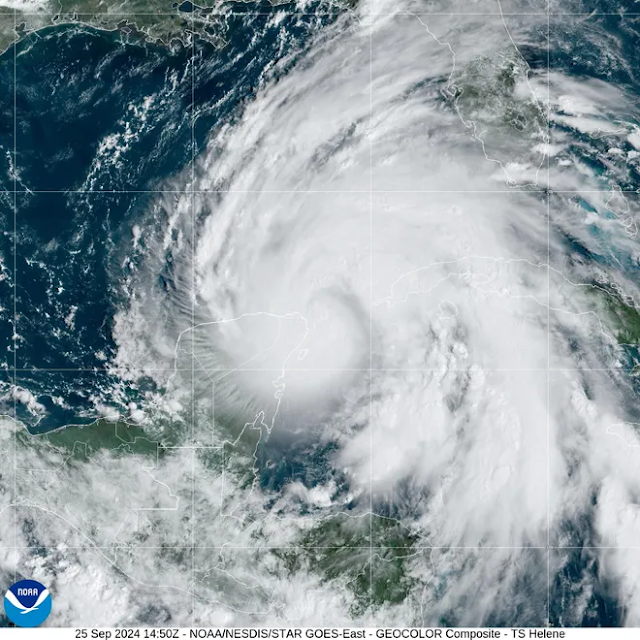(NEWS UPDATE USA FAST)-- At the approach of a powerful storm like Helene to the U.S., meteorologists refer to a five-category system that brings into sharp focus the severe risks these hurricanes pose to people in their paths.
The system is called the Saffir-Simpson Hurricane Wind Scale. In the scale, hurricanes are categorized by maximum sustained wind speeds, from 74 over 157 mph.
However, the scale does not account for other deadly hazards associated with hurricanes, including storm surge, heavy rainfall, flooding, or tornadoes. Many of these hazards require residents to take appropriate life-saving actions, including evacuation for those living in storm surge-prone areas.
Hurricane Helene, expected to make landfall on Florida's Gulf Coast by Thursday, is expected to strengthen through the early part of the week. And as its wind speed increases, so does its ranking on the hurricane wind scale, which runs from Category 1 to 5.
New concern?: Category 5 was considered the most extreme, but recent research indicates that an even more dangerous classification could exist.
The Saffir-Simpson Hurricane Wind Scale is a system that grades hurricanes by wind speeds and provides an appropriate estimation of the probable damage a hurricane will cause. It depicts the severity of a storm and its likely impact for a particular region, especially in the USA. Every increase in category usually means the damage caused increases about fourfold.
It was originally developed in 1969 by the structural engineer Herbert Saffir for a United Nations project; it was then refined in the early 1970s by meteorologist Robert Simpson. Since then, it has been an important tool of the National Hurricane Center in the warnings issued to the public concerning the effects of hurricanes falling within each strength category.
How much damage can Helene cause in Florida?
The overall impact caused by Helene will have much to do with where she makes landfall and how those key factors of flooding, storm surge, and tornado play out. In terms of power outage and structural damage, though, the wind speed and category upon landfall will be important.
As of a Wednesday forecast by the National Hurricane Center, Helene is expected to make landfall Thursday night as a Category 3 hurricane, with winds near 125 mph--just 4 mph shy of Category 4 strength. AccuWeather forecasters have even suggested that Helene could intensify to Category 4 in the Gulf.
If it attains Category 4 strength, the damage would be "catastrophic." The National Hurricane Center says Category 4 storms severely damage well-constructed homes, mostly ripping off roofs and collapsing exterior walls. Most trees are uprooted, and most power lines are knocked down.
In that case, power outages could last for weeks, even months, and a large portion of the area might remain unlivable. As still a Cat 3 storm, Helene would be deadly, destructive, and leave many residents without electricity and/or water for days or weeks.
What is a major hurricane?
Though all hurricanes create dangerous winds, Category 3 and above are classified as major hurricanes capable of causing devasting to catastrophic wind damage and significant loss of life. Yet even Category 1 and 2 hurricanes can be deadly since storm surge, rain-induced flooding, and tornadoes can occur with these storms. In other words, understanding the dangers that present themselves by hurricanes is not one-sided, as even from 1,000 miles away there are specific deadly threats a hurricane can pose, along with other terrifying hazards.
What Are the 5 Hurricane Categories?
1. Category 1 Hurricane (74-95 mph)
Winds within this range are hazardous, if not violent, and of sufficient strength to produce some damage to structures. Roofs of well-built homes may be deeply floored, with some structural damage to exterior doors and windows. Shingles, vinyl siding, and gutters can be damaged. Large tree branches may break. Shallow-rooted trees can be toppled. Power cuts using damage to power lines and poles possibly lasting several days can occur.
Shall I continue with the other categories or does this need a little changing?
Category 2 Hurricane (96-110 mph):
Extremely dangerous winds will cause extensive damage: Well-built framed homes may incur major roof and siding damage. Many shallow-rooted trees will be snapped or uprooted, blocking numerous roads. Near-total power loss is expected, with outages lasting from several days to weeks.
Category 3 Hurricane (Major, 111-129 mph):
Catastrophic damage will occur. Well-built framed homes can expect major roof damage and loss of roof decking and gable ends. Most trees will be snapped or uprooted and power poles downed. Fallen trees and power poles will isolate residential areas. Power outages will last for weeks to possibly months. Most of the area will be uninhabitable for weeks or months.
Category 4 Hurricane (Major, 130-156 mph):
Catastrophic damage will occur. A well-built home may incur severe damage to roof, doors, and windows, including those with exposed structural members. Most windows will be blown out of buildings, entering living areas. Most trees will be snapped or uprooted, blocking access to roads. Power poles will be downed, possibly isolating residential areas. Power outages will last weeks to possibly months. Most of the area will be uninhabitable for weeks or months.
Category 5 Hurricane Major 157 mph+
Catastrophic damage will occur. A high inherent percentage of framed homes will be destroyed, with total roof failure and wall collapse. Fallen trees and power poles will isolate communities. Power outages will last for weeks to months. Most of the affected area will be uninhabitable for weeks.
How often does each category happen?
The most common are Category 1 hurricanes, which may develop up to seven in a year, says Fox Weather. In contrast, on average, only three Category 3 hurricanes develop annually.
The most infrequent ones are Category 5 hurricanes, which have only touched the land in the U.S. four times in history, according to Weather.com.


